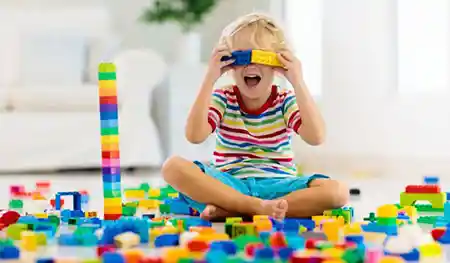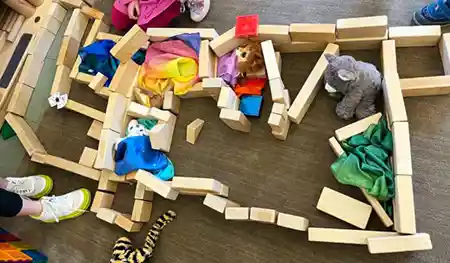Play Patterns in Practice: Play Schemas

Play Patterns in Practice: Using Schemas to Teach with Purpose
In early childhood classrooms, play is never “just” play. It’s language, logic, and learning, all happening in real time, often before a child can articulate it. If you’ve ever noticed a child repeatedly pushing cars down a ramp, lining up dinosaurs in perfect formation, or crawling under tables again and again, you’ve witnessed play schemas at work.
Schemas are patterns of repeated behavior that reveal how children are making sense of their world. Understanding them gives us a powerful lens to plan, observe, and scaffold learning with intention. Whether we call these “play schemas” or “play patterns,” these insights help us partner with their play, connecting the dots between what children naturally do and what we know they’re ready to explore next.
From Theory to Play: A Snapshot of Schemas in Real Life
First introduced by Piaget and expanded by early childhood thinkers like Chris Athey, schemas are the mental frameworks that children develop through physical action. They’re the invisible threads tying together rolling, climbing, collecting, spinning, and sorting. Think of them as blueprints in the brain that get built through movement, trial, repetition, and play. Emphasis here? Physical movement and repetition. That’s the engine of schema-building.
Explore some common categories of play schema below:
Trajectory: Rolling, throwing, running. Exploring movement in straight lines or arcs.
We might see this when children throw things, experiment with tubes and ramps, or repeatedly drop a sippy cup from their highchair. It’s not only about movement, but also cause and effect, force, and direction.
Some materials that support trajectory play:
Kodo Rubber Ramp with Stackers
Enclosure: Creating boundaries or surrounding objects, often to contain or define space.
Have you ever noticed a child arranging blocks in a circle or square, drawing shapes that “trap” other shapes or characters, or building pens or “homes” for animals and toys? The focus is creating and defining spaces.
Enveloping: Exploration of covering objects or themselves.
Children might wrap toys in fabric, hide objects in containers, or crawl under blankets or into boxes. This kind of play helps them understand ideas like inside/outside, hiding/revealing, and containment. It's their way of learning about space, boundaries, and object permanence.
Some materials that support enclosure and enveloping play:
Transporting: Moving objects from one place to another, often with baskets, vehicles, bags, or hands.
You’ve seen it when a child loads toys into a basket, carries them across the room, dumps them, and then starts again. Or when they push a stroller filled with blocks from one corner to the next, and back again ... perhaps with sessions of loading and unloading in between.
Some materials that support transporting play:
Baby Doll Basket (soft, handled basket, great for more than baby dolls!)
Rotation: Interest in spinning objects or turning in circles themselves. You’ll spot this when a child spins in circles, twists on a swing, turns a toy wheel endlessly, or becomes fascinated by toys, tools, or household objects like tops, salad spinners, and turning knobs.
Some materials that support rotation play:
Sit and Twist Active Seat Cushion
Gears! Gears! Gears! Activity Set
Positioning: Arranging items in specific ways, often lining things up or organizing by category.
We notice this when children line up cars with precision, sort buttons by color or size, or invest a lot of time and attention placing every animal just right on a shelf. Positioning is about order, sequence, and spatial relationships.
Some materials that support positioning play:
Orientation: Exploring how things look from different angles or positions.
You might see a child hanging upside down, tilting their head to look at something sideways, crawling under a table, or climbing to see from above. Through this play, they’re figuring out how their body moves in space and how the world changes depending on where and how they look at it. It’s all about perspective.
Some materials that support orientation and perspective play:
Connecting: Linking items together: tying, taping, building, linking.
Have you ever noticed a child taping together cardboard scraps, snapping magnetic tiles into long chains, or tying string from chair to chair to build a “web”? These are examples of connection play and explorations of how things attach, link, and hold.
Some materials that support connecting play:
Transformation: Exploring how things change through mixing, combining, or imagining one thing becoming another.
You’ll notice this when a child mixes sand and water into “soup,” turns playdough into a birthday cake, or pretends a cardboard tube is a telescope. It can be physical change (changing materials or properties) or a symbolic one (changing meaning). This can often show up as “deconstruction,” and in this lane, can easily be misinterpreted as destructive behavior. In all of its forms, this schema pattern is how children make sense of change and cause and effect by experimenting, pretending, and creating something new.
Some materials that support transformation play:
Schemas aren’t always tidy. In fact, they often show up in ways adults find frustrating, like dumping out bins, throwing blocks, or running indoors. But when we recognize the why behind the behavior, our responses can shift from reactive to responsive.

Where Schemas Take Us: Deeper Learning in Action
This kind of play naturally supports how young children learn best. It honors each child’s unique interests and ways of exploring the world, like the toddler who insists on carrying every single block across the room before building, or the preschooler who spins and twirls through circle time because her body is asking to understand movement. When we notice these patterns, we can document what’s unfolding and respond with intention. A teacher might invite a child who's always hiding under tables to help design a cozy library spot, or offer beanbags and a laundry basket target to children who are insistent on refining their throwing skills indoors.
When educators recognize schemas in action, we begin to see children as active theory-builders. They are:
- Practicing prediction and cause-effect reasoning
- Exploring physics, space, and sensory input
- Building persistence, concentration, and agency
- Regulating sensory input
When educators tune into these patterns, they can make powerful choices about the materials they offer, the invitations they extend, and the questions they ask. These thoughtful shifts affirm that children’s play has purpose.
Bringing Play Patterns to Life in Your Classroom
So how do we make this more than theory? We can use a schema-lens as a planning and observation tool.
1. Observe Without Judgment: Watch for what children repeat, not just what they complete. In other words, the pattern might be in how the child engages with materials, not necessarily in what activity they choose. While sitting at the art table, you might notice one child most interested in giving their markers the tiniest nudge and then watching it roll all the way across the table and on to the floor. That might be trajectory play. Ever had a child that loved to snap a series of markers cap-to-end? That’s likely connection play in action. Start noting these patterns.
2. Name the Schema, Then Plan: Use schema language to guide your planning. If you notice several children exploring enclosure schemas, consider materials like hula hoops, large cardboard boxes, tunnels, or even materials for drawing fences or boundaries. Be sure to check out our helpful resource: Play Schemas Quick Reference and Reflection Guide.
3. Co-Construct the Environment: Design play spaces that reflect the schemas you observe. For example, adding pulleys, tubes, and ramps to your block area can support children exploring movement and transport. Offer a variety of baskets, boxes, and bags to encourage carrying and collecting. Children often show us what they need next through the materials they seek out or repurpose.
4. Engage Families: Play patterns don’t stop at the classroom door. You can bet that families observe some of the same repeated activities. Share examples and photos to help them see the meaning behind their child’s play at home. This kind of partnership strengthens the bridge between home and school and affirms families as co-learners in their child’s development.
5. Reframing Behavior Management: When we understand play patterns, guidance becomes less about control and more about curiosity. Instead of asking, “How do I stop this behavior?” we can start wondering, “What is this child working on? What’s the schema underneath?” While we still uphold classroom safety and community expectations, redirecting children when needed to keep everyone safe, this lens helps us shift our role from interrupters to interpreters. It also helps us be proactive in building environments where children feel seen, empowered, and challenged in meaningful ways.
Growing our Practice with a Play Pattern Lens
Schemas remind us that play isn’t random. It’s rarely intentionally disruptive. Most often, it’s guided by a child’s innate wisdom, an intuitive knowing of what they need in that moment to make sense of the world around them. When we arrive with a commitment to observation and trust, we can more easily grow a habit of being reflective, not reactive.
Like so many aspects of a teaching practice grounded in valuing play as real learning, we can activate a “Name, Notice, and Extend” approach. By identifying and supporting children’s schemas, we foster deeper engagement, reduce power struggles, and cultivate genuinely responsive classrooms. When we pause to see these patterns, we catch a glimpse of a child’s private map of the world. In those moments, in the repeated, insistent gestures, we’re invited to slow down, to listen, and to delight in what children are sharing with us without words.
Resources
INFOGRAPHIC: Ten Tips for Supporting Play Schema
INFOGRAPHIC: Play Schemas Quick Reference and Reflection Guide.
WEBINAR: Play Patterns Unpacked: Making Sense of the Why Behind the Play

Christine Murray is an Early Childhood Education Specialist with Becker’s Education Team.
As an educator, coach and leader, Christine is inspired by the curiosity, joy and wonder that children so generously model for us. She earned her M.A. in Innovative Early Childhood Education at the University of Colorado Denver and loves collaborating with and supporting others in the field. Grounded in relationships and guided by empathy, Christine is always learning, connecting and creating.
